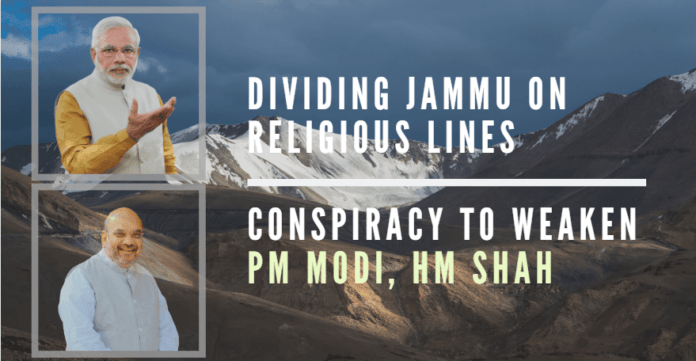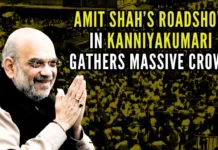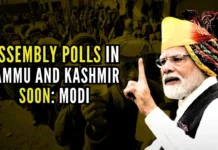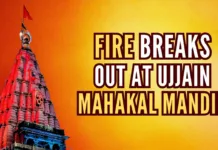
It is heartening to note that the concerned citizens in Jammu understood the dangerous implications of the latest development (proposal to create a new division) and opposed it vehemently.
There were reports that the government of the Union Territory of Jammu & Kashmir had given its nod to carve out a new division consisting of Jammu’s Doda, Kishtwar and Ramban districts and Kashmir’s Anantnag, Kulgam and Shopian districts. There were also reports that the “initial survey in this regard had already been conducted and the authorities were deliberating on a survey report to give final shape to the proposal”.
Former PM Manmohan Singh had admitted that his government was all set to adopt the Musharraf formula to resolve the Kashmir issue and harmonize India-Pakistan relations, but the fall of Musharraf failed the move.
“The aim of this plan was to ensure better governance and administration to the people living in the remotest and far-flung areas. After going through the survey conducted by a Central agency, the authorities will prepare a roadmap for the proposed new division,” the reports said and added that “a dedicated team had already been deployed for this project” (Amarujala, Nov 23; Tribune, Nov 24, 2019)[1].
The proportion of Muslims and Hindus in Doda, Kishtwar and Ramban districts is 55:45. As for Anantnag, Kulgam and Shopian districts, these became almost 100 percent Muslim in January 1990, when the radical Islamists threw all the Hindus out of Kashmir.
Indeed, these were dangerous reports. These reports suggested that the votaries of “Greater Muslim Kashmir” in the establishment had become active to misguide the Narendra Modi Government and help the break-India forces establish their control over the strategic and mighty Pir Panjal Mountain (a natural wall between Jammu and Kashmir) and the precious Chenab Waters. (Chenab is in Jammu.) In other words, those unhappy with the decision of the Narendra Modi Government to dilute Article 370, abrogate Article 35A, scrap the Jammu & Kashmir Constitution and bifurcate the state into Union Territories of Jammu & Kashmir and Ladakh thought of a new sinister plan to defeat the very objective of the Narendra Modi Government’s new nation-centric reform scheme. The whole objective of the Narendra Modi Government behind the new reform scheme is to defeat the Pakistani break-India moves, eliminate the menace of terrorism, break the backbone of the separatists in Kashmir and defeat the kind of politics Kashmiri leaders had played after 1947 to foment anti-India troubles, promote politics of separation based on religious fanaticism and jeopardize the legitimate socio-economic and political rights of the people of Jammu and Ladakh.
It was not the first occasion when certain elements in the political establishment sought to mislead the powers-that-be at the Centre and in the state with a view to breaking Jammu or eroding its age-old distinct identity and helping Pakistan achieve what it had been unsuccessfully seeking to achieve since 1947. It was on September 15, 1950 that a suggestion to divide Jammu or de-link from the Jammu province Doda, Kishtwar and Ramban areas (parts of Udhampur district till 1948) were mooted. It was Own Dixon, an Australian jurist selected or appointed by the United Nations to mediate between India and Pakistan on the Jammu & Kashmir issue, who had in his nasty report suggested division of Jammu province. It had also suggested that Ladakh and Hindu-majority areas of Jammu province be made part of India, Pakistan-occupied-Jammu & Kashmir and Gilgit-Baltistan be assigned to Pakistan. Not just this, he had also suggested plebiscite in Kashmir, despite the fact that the UN resolutions nowhere suggested region or district-wise plebiscite. The Government of India of the time had rejected the Dixon Plan out-of-hand.
However, Chenab Formula or the Farooq Kathwari Formula and the Musharraf’s Formula had also put forth almost similar suggestion as far as Jammu province was concerned: Division of Jammu province. The Musharraf Formula had suggested four more steps as a final solution to the so-called Kashmir issue. It had suggested de-militarization of Jammu & Kashmir, India-Pakistan join-control on Jammu & Kashmir, self-governance and porous borders/porous Line of Control. The Vajpayee Government and the Manmohan Singh Government were not hostile to the Musharraf Formula. However, they couldn’t move forward because of certain develo0pments both in India and Pakistan. Former PM Manmohan Singh had admitted that his government was all set to adopt the Musharraf formula to resolve the Kashmir issue and harmonize India-Pakistan relations, but the fall of Musharraf failed the move. The fact of the matter is that the Congress Government had almost decided to compromise the age-old stand of India on Jammu & Kashmir.
It was no wonder then that the people of Jammu and Ladakh and the internally-displaced Kashmiri Hindus all opposed tooth and nail all these divisive solutions or formulas.
That the Congress Government had compromised the Indian position on Jammu & Kashmir could be seen from what Sartaj Aziz former Foreign Minister of Pakistan in the government of General Pervez Musharraf, claimed in 2009. He claimed that “an agreement between his country and India had been reached on the Jammu & Kashmir issue on the basis of its division so that the Hindu-majority part of Jammu and the Buddhist-majority part of Ladakh remained with India and the Pakistan-occupied-Jammu & Kashmir with Pakistan as the views of the people were known. The area of dispute was confined to the Kashmir Valley”. He had “quoted Farooq Kathwari formula on the subject” (Mainstream, February 13, 2010)[2].
It would not be out of place to mention here that the “Self-Rule” document of the People’s Democratic Party (PDP) of late Mufti Mohammad Sayeed and Mehbooba Mufti (now under detention) was almost a carbon-copy of the Musharraf Formula. It had also talked about de-militarization, porous borders, self-rule, joint-control, shared sovereignty, dual currency, Islamic banking, and whatnot. To be more precise, the Dixon Plan, the Chenab Formula, the Kathwari Formula, the Musharraf Formula, the Self-Rule solution and the National Conference’s Autonomy Doctrine were all break-India solutions.
It was no wonder then that the people of Jammu and Ladakh and the internally-displaced Kashmiri Hindus all opposed tooth and nail all these divisive solutions or formulas. Their view was, and is: the acceptance and implementation of any of these formulas will (1) help Pakistan cause another communal division of India and (2) create a Pakistan-like situation in Jammu, Kashmir and Ladakh where the political status and the plight of the minorities would be no different from the plight of Mohajirs, Hindus, Sikhs, Buddhists, Jains, Parsis and Christians in Pakistan, Bangladesh, and Afghanistan. The attitude of the nation as a whole towards these so-called solutions was no different as it was unwilling to accept one more partition of India on communal basis.
It is heartening to note that the concerned citizens in Jammu understood the dangerous implications of the latest development (proposal to create a new division) and opposed it vehemently. They described the move as “a war on Jammu” and “a dangerous trap” and urged Prime Minister Narendra Modi and Home Minister Amit Shah to reject with contempt the idea of de-linking Jammu’s Doda, Kishtwar and Ramban districts and merging them with the terrorist-infested Anantnag, Kulgam and Shopian districts to create one more division in the Union Territory of Jammu & Kashmir. They accused “the enemies within of hatching a conspiracy against the Prime Minister and the Home Minister”.
It’s also a matter of satisfaction that Minister of State in the Prime Minister’s Office Jitendra Singh, Farooq Khan, Advisor to Lt Governor of Union Territory of Jammu & Kashmir, and the Jammu & Kashmir BJP spokesperson Anil Gupta on December 5 cleared all the cobwebs of confusion and said in unambiguous terms that “there was no plan to divide Jammu province or create one more division in the Union Territory of Jammu & Kashmir”. That three persons had to come forward to issue a clarification speaks volumes.
Note:
1. The views expressed here are those of the author and do not necessarily represent or reflect the views of PGurus.
References:
[1] Police reforms on cards in J&K, post of Commissioner to be created – 24 November, 2019, Tribune
[2] How Communal Division of J&K State was Averted – February 13, 2010, Mainstream
- ‘Kashmir My core constituency’: Revisiting July 12, 2003 to understand politics, Omar Abdullah-style - March 15, 2024
- Total deviation from traditional approach: Seven takeaways from PM Modi’s March 7 Srinagar visit - March 9, 2024
- Status of political parties: Why is further J&K reorganization imperative? - March 1, 2024











So to confirm, the report or plan suggested lumping 55% Muslim areas of Jammu with 100% muslim areas of Jammu to create a new Muslim Jammu constituency?